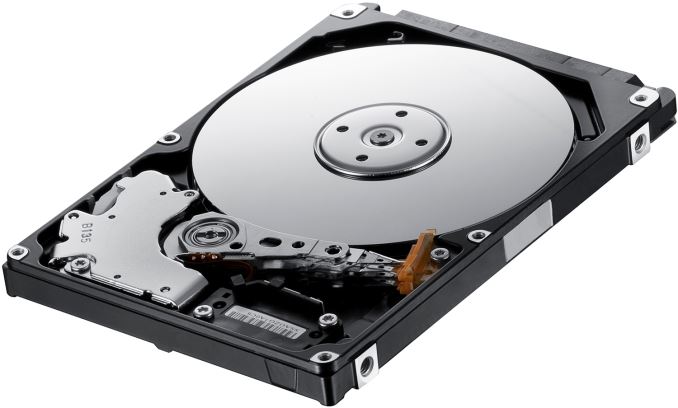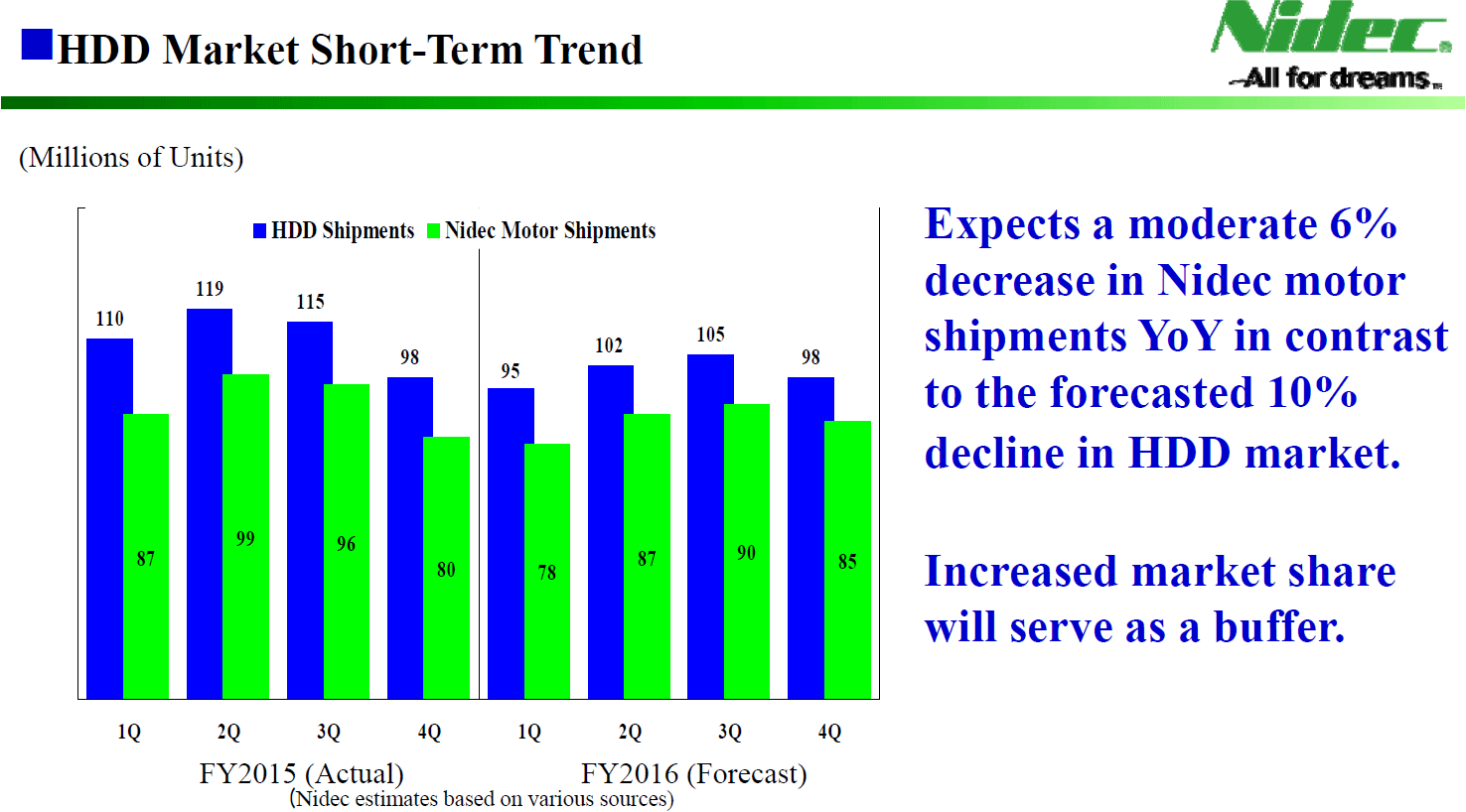Market Views: HDD Shipments Down 20% in Q1 2016, Hit Multi-Year Low
by Anton Shilov on May 12, 2016 8:00 AM ESTFinal Words
The storage market in the first quarter of 2016 performed in accordance with the PC market trends in general. Shipments of HDDs went down, but sales of high-capacity nearline hard drives remained a bright spot in the reports of leading hard drive suppliers. Western Digital remains optimistic in the short term for HDDs, but Seagate detailed plans to severely cut its production capacities and to reduce its presence the market of low-end mobile HDDs.
As ultra-thin notebooks, as well as 2-in-1 hybrid PCs, are gaining market share, the potential for 2.5” client HDDs suffers. Theoretically, sales of 2.5” drives for AIO and small form-factor desktops could offset declines in the mobile (at the expense of 3.5” HDDs declines), but this did not happen in Q1: sales of Seagate’s 2.5” client HDDs dropped to 10.6 million units (down 37% YoY), whereas shipments of Western Digital’s 2.5” client drives declined to 13.577 million units (down 28% YoY).
This quarter Seagate announced plans to discontinue some of its 2.5” low-capacity (500 GB and lower) client drives and concentrate on promoting 1 TB and 2 TB 2.5” models based on its latest technologies. Basically, Seagate no longer wants to compete against entry-level TLC NAND-based SSDs in low-end and mainstream notebooks. Reducing participation in this market segment will allow Seagate to simplify the portfolio of components it purchases from other makers and cut down its costs as high-capacity platters for advanced drives are made mostly in-house. It will be very interesting to see how other HDD makers respond to this action. They face similar problems and eventually it will only get harder to compete against cheap SSDs.
Shipments of 3.5” client hard drives hit a new low in the first three months of this year, which was not completely surprising, given slow shipments of PCs. So far neither Seagate nor Western Digital has announced plans to optimize their 3.5” lineups (WD actually folded its Green drives into its Blue lineup last year), but this is something that will likely happen in the future.
Enterprise HDD business is a mixed bag these days. On the one hand, sales of 10K and 15K HDDs are declining because of SSDs and that decline has yet to bottom out. Yet, those hard disks remain expensive and the business overall is profitable. On the other hand, sales of nearline drives are on the rise. More importantly, the growth of average capacities of such HDDs even outpaces the growth in their unit sales. Interestingly, Seagate indicated that demand for high-end 8 TB nearline HDDs was so strong in Q1 2015 that it could not even fulfill the orders placed. Seagate’s rather unexpected start of 10 TB HDD revenue shipments in April proves that operators of data center are rapidly building up capacities.
Seeing the fact that HDD sales volumes have been falling for many quarters now, Seagate not only decided to exit the market of low-end notebook drives but also detailed its plans to steeply cut-down its manufacturing capacities to 35 – 40 million units per quarter from 55 – 60 million units per quarter. From now on, the company will focus on high-capacity HDDs that are sold at higher prices rather than on affordable drives for bulk storage, which will naturally help it to avoid direct competition against SSDs in the entry-level segment where capacity may not be that important. It remains to be seen what Seagate will do with the manufacturing equipment that it will not need after its optimizations, but that is a different conversation entirely.
Looking ahead, Western Digital believes that the HDD TAM will remain above a psychologically important 400 million units per year mark (shipments of HDDs last year were around 453.6 million units), but will drop in the long term. Meanwhile, Nidec conservatively predicts that HDD TAM will fall to 400 million units in 2016 with shipments of PC and external HDDs declining the most. The upcoming quarters will show whether optimistic or conservative predictions are applicable to today’s HDD market.
Methodology and Important Notices
There are three major manufacturers of hard drives today: Seagate, Toshiba and Western Digital. Other suppliers are reselling hard drives made by these three companies.
Seagate and Western Digital reveal their HDD unit shipments as well as TAM (total available market) estimates every fiscal quarter. While such numbers are considered preliminary, they are usually rather accurate and re-affirmed by third-party analysts. Our TAM is the midpoint between Seagate’s and Western Digital’s TAM estimates. If only one hard drive maker reveals its TAM, we consider the number from only one vendor.
Meanwhile Toshiba does not officially disclose its HDD shipments. We subtract quarterly shipments of Seagate and Western Digital from our TAM estimate to get the number of drives sold by Toshiba. The approach is is the reason why we do not report historical shipments of Toshiba prior to Q3 2012. Based on estimates of hard drive makers and industry observers, Toshiba cannot produce more than 22 – 23 million of HDDs per quarter.
Seagate’s and Western Digital’s fiscal quarters end on the last business day of the last week of a calendar quarter (e.g., the Friday next to December 31). While fiscal quarters of HDD makers may not correspond exactly to calendar quarters, they are very close. Fiscal years of Seagate and Western Digital do not correspond to calendar years as they begin in July.
Historical TAM data comes from financial reports of Seagate and Western Digital.
Note 1: Seagate completed the acquisition of Samsung’s HDD business in December, 2011. The company started to include sales of Samsung-branded HDDs in its quarterly shipments in Q1 2012 (Q3 FY2012).
Note 2: Western Digital closed the acquisition of Hitachi Global Storage Technologies in March, 2012. Western Digital began to include HGST shipments in its financial reports in Q2 2012 (Q4 FY2012).
Note 3: Toshiba acquired some of Western Digital’s 3.5-inch HDD manufacturing equipment and intellectual property in May, 2012. It was expected that the manufacturing transfer could be complete within 6 to 12 months. Western Digital made HDDs for Toshiba on a contract basis until late Q4 2012. Due to the contract manufacturing agreement between Western Digital and Toshiba in 2012, there may be some inaccuracies in the historical data in that period (i.e., since the drives were made by Western Digital and then sold to Toshiba, they are attributed to the former, not the latter).
Note 4: Seagate defines client HDDs as 2.5” and 3.5” hard drives for desktops, notebooks and hybrid PCs as well as game consoles. Seagate considers HDDs for external storage and network-attached storage (NAS) as “branded” drives. Hard disks for DVRs and surveillance systems belong to Seagate’s family of HDDs for consumer electronics. Enterprise lineup includes 2.5” and 3.5” drives for mission critical (SAS, SCSI, Fibre Channel), enterprise storage, nearline and other datacenter applications.
Note 5: Western Digital attributes desktop and mobile 2.5” and 3.5” hard drives to client HDDs. External hard drives and NAS are referred to as “branded products”. Western Digital’s consumer electronics HDDs are used in DVRs, game consoles, video streaming applications and security video recording systems.












116 Comments
View All Comments
darkfalz - Thursday, May 12, 2016 - link
Waiting for external drives of 8 or 10 TB (not SMR). Then I'll buy a couple more.takeshi7 - Thursday, May 12, 2016 - link
They've had non-SMR 8TB drives for a while now, and you can buy a 10TB non-SMR drive right now.http://www.amazon.com/Seagate-Enterprise-Capacity-...
DanNeely - Thursday, May 12, 2016 - link
External drives are the cheap low RRM, low duty cycle models. Helium has only be used in the eye searingly expensive enterprise drives.takeshi7 - Thursday, May 12, 2016 - link
You can get an 8TB non-SMR air based desktop drive and put it in an external enclosure, but honestly I'd save my money and just get the SMR drive. SMR isn't that bad for writing large sequential files, like videos, and reads are just as fast as a normal drive. Unless you're doing something really demanding SMR is fine, and if you are doing something demanding you'd be better off with some sort of expensive RAID setup, anyways.Lolimaster - Friday, May 13, 2016 - link
I would stick to at most a WD Blue 6TB until HARM finally arrives.15-20TB disks.
JimmiG - Friday, May 13, 2016 - link
SMR is almost a perfect match for the kind of massive media library or backups that you might use an HDD for these days. Unless you're modifying/overwriting data, the firmware will ensure that the data is written to "pristine" tracks. Even when you do modify data, there's the non-SMR buffer. There's the issue with RAID, but most RAID modes are a bad idea with >2TB drives anyway.90 million units is hardly a "niche" market, and HDDs will remain for many years to come. There's just no other option if you need to store more than a terabyte or two of data, especially when you don't actually need the superior performance of the SSD (such as media libraries and backups).
Wolfpup - Thursday, July 14, 2016 - link
I'm just nervous about reliability with those SMR drives. Maybe I'm concerned for no reason, but I feel like storage tech is fragile enough as it is.The SMR externals were like $220 or so for a Seagate, versus $350 for a "normal" drive (and then I had to buy an enclose). So far so good though, using them for a few months.
Wolfpup - Thursday, July 14, 2016 - link
Wowzers, 10TB? I didn't know that... I just bought 8TB Seagate NAS drives a few months ago. Almost double the price of the SMR drives, but I'm just nervous about those.Wolfpup - Thursday, July 14, 2016 - link
Segate JUST released 8TB internal drives. I bought an enclosure that can hold 4 drives, + 2 8TB drives. They're...umm...I guess they're considered NAS drives. They were like $350 a piece though, something like that, but I need every scrap of space I can get, and I didn't really trust that new SMR tech.NeatOman - Thursday, May 12, 2016 - link
I try to never use a mechanical HDD when ever i can, and now that SSD's are $60 for 250GB and come with 3 or 5 year warranties its perfect. Most people will never fill a 250GB drive with just pictures and music. But i still recommend using a HDD as a backup and only using while backing up.